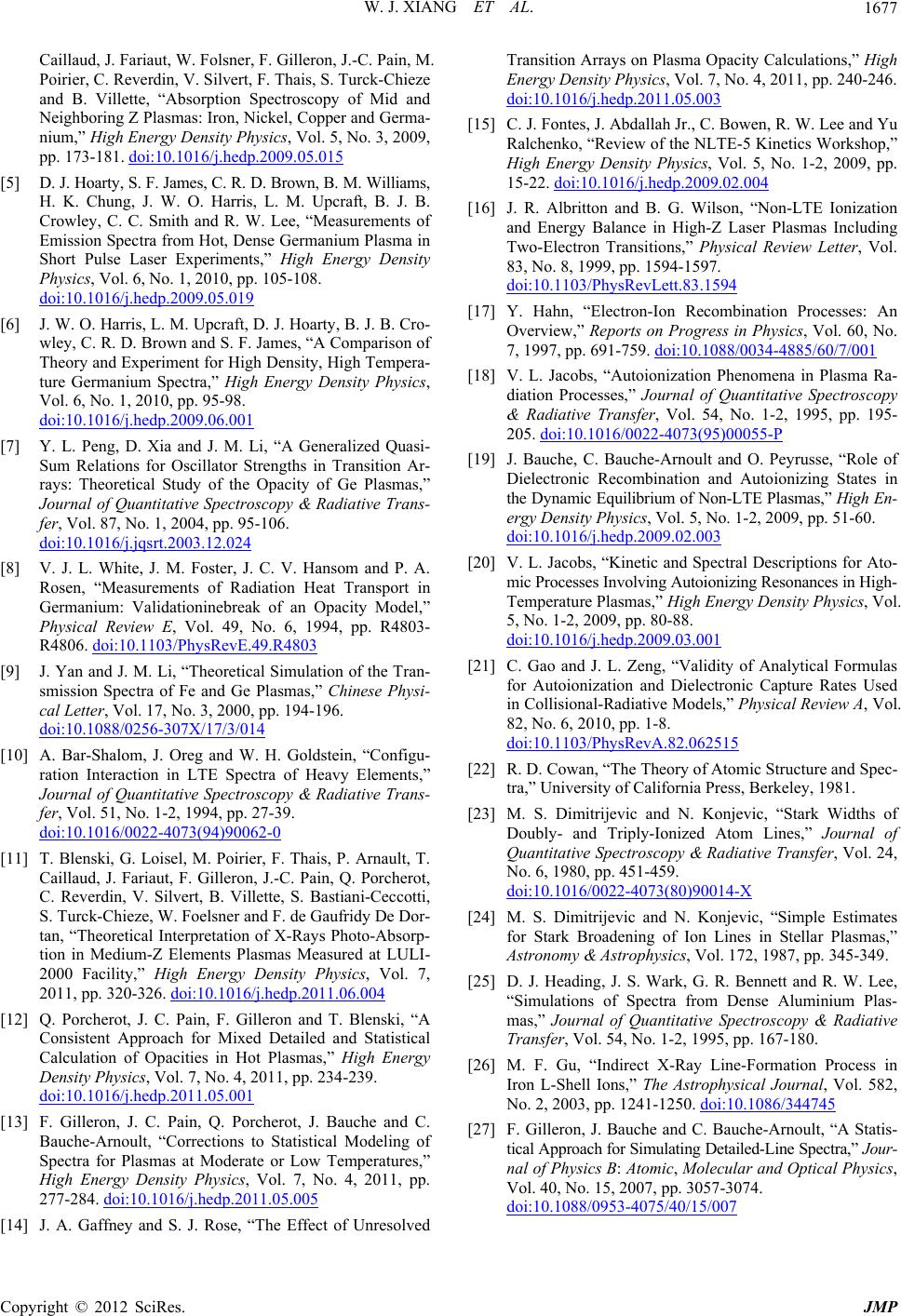
W. J. XIANG ET AL.
Copyright © 2012 SciRes. JMP
1677
Caillaud, J. Fariaut, W. Folsner, F. Gilleron, J.-C. Pain, M.
Poirier, C. Reverdin, V. Silvert, F. Thais, S. Turck-Chieze
and B. Villette, “Absorption Spectroscopy of Mid and
Neighboring Z Plasmas: Iron, Nickel, Copper and Germa-
nium,” High Energy Density Physics, Vol. 5, No. 3, 2009,
pp. 173-181. doi:10.1016/j.hedp.2009.05.015
[5] D. J. Hoarty, S. F. James, C. R. D. Brown, B. M. Williams,
H. K. Chung, J. W. O. Harris, L. M. Upcraft, B. J. B.
Crowley, C. C. Smith and R. W. Lee, “Measurements of
Emission Spectra from Hot, Dense Germanium Plasma in
Short Pulse Laser Experiments,” High Energy Density
Physics, Vol. 6, No. 1, 2010, pp. 105-108.
doi:10.1016/j.hedp.2009.05.019
[6] J. W. O. Harris, L. M. Upcraft, D. J. Hoarty, B. J. B. Cro-
wley, C. R. D. Brown and S. F. James, “A Comparison of
Theory and Experiment for High Density, High Tempera-
ture Germanium Spectra,” High Energy Density Physics,
Vol. 6, No. 1, 2010, pp. 95-98.
doi:10.1016/j.hedp.2009.06.001
[7] Y. L. Peng, D. Xia and J. M. Li, “A Generalized Quasi-
Sum Relations for Oscillator Strengths in Transition Ar-
rays: Theoretical Study of the Opacity of Ge Plasmas,”
Journal of Quantitative Spectroscopy & Radiative Trans-
fer, Vol. 87, No. 1, 2004, pp. 95-106.
doi:10.1016/j.jqsrt.2003.12.024
[8] V. J. L. White, J. M. Foster, J. C. V. Hansom and P. A.
Rosen, “Measurements of Radiation Heat Transport in
Germanium: Validationinebreak of an Opacity Model,”
Physical Review E, Vol. 49, No. 6, 1994, pp. R4803-
R4806. doi:10.1103/PhysRevE.49.R4803
[9] J. Yan and J. M. Li, “Theoretical Simulation of the Tran-
smission Spectra of Fe and Ge Plasmas,” Chinese Physi-
cal Letter, Vol. 17, No. 3, 2000, pp. 194-196.
doi:10.1088/0256-307X/17/3/014
[10] A. Bar-Shalom, J. Oreg and W. H. Goldstein, “Configu-
ration Interaction in LTE Spectra of Heavy Elements,”
Journal of Quantitative Spectroscopy & Radiative Trans-
fer, Vol. 51, No. 1-2, 1994, pp. 27-39.
doi:10.1016/0022-4073(94)90062-0
[11] T. Blenski, G. Loisel, M. Poirier, F. Thais, P. Arnault, T.
Caillaud, J. Fariaut, F. Gilleron, J.-C. Pain, Q. Porcherot,
C. Reverdin, V. Silvert, B. Villette, S. Bastiani-Ceccotti,
S. Turck-Chieze, W. Foelsner and F. de Gaufridy De Dor-
tan, “Theoretical Interpretation of X-Rays Photo-Absorp-
tion in Medium-Z Elements Plasmas Measured at LULI-
2000 Facility,” High Energy Density Physics, Vol. 7,
2011, pp. 320-326. doi:10.1016/j.hedp.2011.06.004
[12] Q. Porcherot, J. C. Pain, F. Gilleron and T. Blenski, “A
Consistent Approach for Mixed Detailed and Statistical
Calculation of Opacities in Hot Plasmas,” High Energy
Density Physics, Vol. 7, No. 4, 2011, pp. 234-239.
doi:10.1016/j.hedp.2011.05.001
[13] F. Gilleron, J. C. Pain, Q. Porcherot, J. Bauche and C.
Bauche-Arnoult, “Corrections to Statistical Modeling of
Spectra for Plasmas at Moderate or Low Temperatures,”
High Energy Density Physics, Vol. 7, No. 4, 2011, pp.
277-284. doi:10.1016/j.hedp.2011.05.005
[14] J. A. Gaffney and S. J. Rose, “The Effect of Unresolved
Transition Arrays on Plasma Opacity Calculations,” High
Energy Density Physics, Vol. 7, No. 4, 2011, pp. 240-246.
doi:10.1016/j.hedp.2011.05.003
[15] C. J. Fontes, J. Abdallah Jr., C. Bowen, R. W. Lee and Yu
Ralchenko, “Review of the NLTE-5 Kinetics Workshop,”
High Energy Density Physics, Vol. 5, No. 1-2, 2009, pp.
15-22. doi:10.1016/j.hedp.2009.02.004
[16] J. R. Albritton and B. G. Wilson, “Non-LTE Ionization
and Energy Balance in High-Z Laser Plasmas Including
Two-Electron Transitions,” Physical Review Letter, Vol.
83, No. 8, 1999, pp. 1594-1597.
doi:10.1103/PhysRevLett.83.1594
[17] Y. Hahn, “Electron-Ion Recombination Processes: An
Overview,” Reports on Progress in Physics, Vol. 60, No.
7, 1997, pp. 691-759. doi:10.1088/0034-4885/60/7/001
[18] V. L. Jacobs, “Autoionization Phenomena in Plasma Ra-
diation Processes,” Journal of Quantitative Spectroscopy
& Radiative Transfer, Vol. 54, No. 1-2, 1995, pp. 195-
205. doi:10.1016/0022-4073(95)00055-P
[19] J. Bauche, C. Bauche-Arnoult and O. Peyrusse, “Role of
Dielectronic Recombination and Autoionizing States in
the Dynamic Equilibrium of Non-LTE Plasmas,” High En-
ergy Density Physics, Vol. 5, No. 1-2, 2009, pp. 51-60.
doi:10.1016/j.hedp.2009.02.003
[20] V. L. Jacobs, “Kinetic and Spectral Descriptions for Ato-
mic Processes Involving Autoionizing Resonances in High-
Temperature Plasmas,” High Energy Density Physics, Vol.
5, No. 1-2, 2009, pp. 80-88.
doi:10.1016/j.hedp.2009.03.001
[21] C. Gao and J. L. Zeng, “Validity of Analytical Formulas
for Autoionization and Dielectronic Capture Rates Used
in Collisional-Radiative Models,” Physical Review A, Vol.
82, No. 6, 2010, pp. 1-8.
doi:10.1103/PhysRevA.82.062515
[22] R. D. Cowan, “The Theory of Atomic Structure and Spec-
tra,” University of California Press, Berkeley, 1981.
[23] M. S. Dimitrijevic and N. Konjevic, “Stark Widths of
Doubly- and Triply-Ionized Atom Lines,” Journal of
Quantitative Spectroscopy & Radiative Transfer, Vol. 24,
No. 6, 1980, pp. 451-459.
doi:10.1016/0022-4073(80)90014-X
[24] M. S. Dimitrijevic and N. Konjevic, “Simple Estimates
for Stark Broadening of Ion Lines in Stellar Plasmas,”
Astronomy & Astrophysics, Vol. 172, 1987, pp. 345-349.
[25] D. J. Heading, J. S. Wark, G. R. Bennett and R. W. Lee,
“Simulations of Spectra from Dense Aluminium Plas-
mas,” Journal of Quantitative Spectroscopy & Radiative
Transfer, Vol. 54, No. 1-2, 1995, pp. 167-180.
[26] M. F. Gu, “Indirect X-Ray Line-Formation Process in
Iron L-Shell Ions,” The Astrophysical Journal, Vol. 582,
No. 2, 2003, pp. 1241-1250. doi:10.1086/344745
[27] F. Gilleron, J. Bauche and C. Bauche-Arnoult, “A Statis-
tical Approach for Simulating Detailed-Line Spectra,” Jour-
nal of Physics B: Atomic, Molecular and Optical Physics,
Vol. 40, No. 15, 2007, pp. 3057-3074.
doi:10.1088/0953-4075/40/15/007